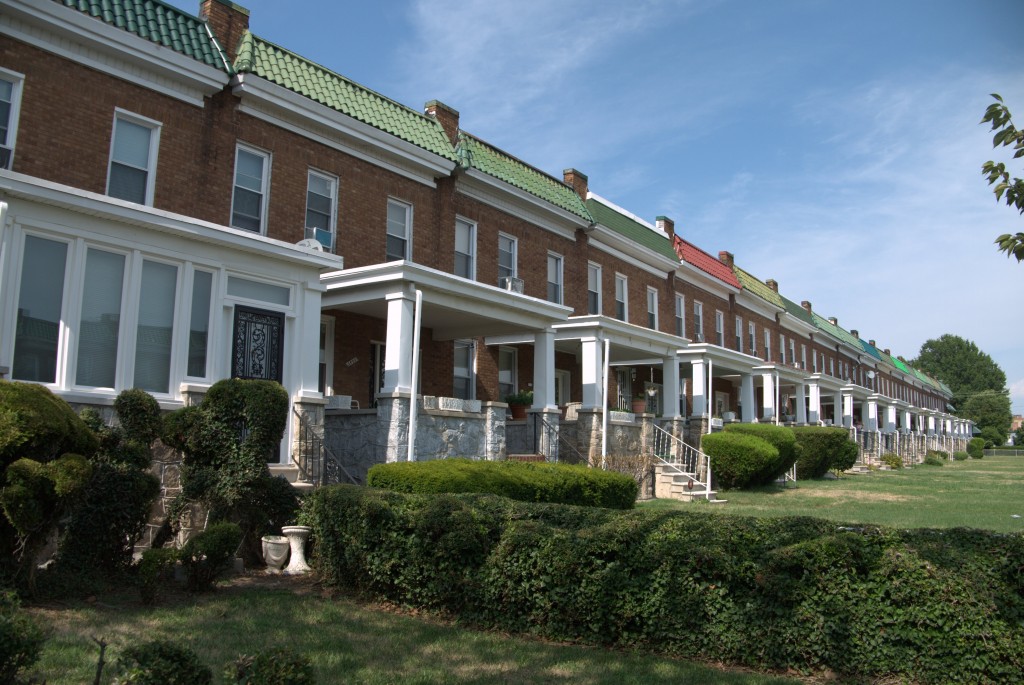Race, place, and public housing in Baltimore: Baltimore Heritage’s Thursday lecture will use public housing as a point of entry for discussing race, segregation and history, Baltimore Brew, October 20, 2010
Author: Eli
Eli Pousson started as a Field Officer at Baltimore Heritage in partnership with the National Trust for Historic Preservation in October 2009. Prior to moving to Baltimore, Eli worked for the DC Office of Historic Preservation and completed graduate work in anthropology and historic preservation at the University of Maryland College Park. Eli continues to work with the Lakeland Community Heritage Project and other heritage organizations in Prince George’s County, Maryland.
Join us this Thursday for Rethinking Urban History from the Margins!
 Please join us this Thursday, October 21 is our annual Fall Baltimore Heritage Lecture called “Rethinking Urban History from the Margins” by Dr. Rhonda Y. Williams, a Baltimore native and associate professor at Case Western Reserve University. Note that the location has moved from Ebenzer AME Church to Saints Stephen & James Evangelical Lutheran Church (938 S. Hanover Street, 21230).
Please join us this Thursday, October 21 is our annual Fall Baltimore Heritage Lecture called “Rethinking Urban History from the Margins” by Dr. Rhonda Y. Williams, a Baltimore native and associate professor at Case Western Reserve University. Note that the location has moved from Ebenzer AME Church to Saints Stephen & James Evangelical Lutheran Church (938 S. Hanover Street, 21230).
Date: Thursday, October 21, 2010
Time: 7:00 p.m. to 8:30 p.m.
Location: Saints Stephen & James Evangelical Lutheran Church (938 S. Hanover Street, Baltimore 21230)
(This is in the historic Sharp-Leadenhall neighborhood)
Cost: Free!
RSVP: Click here to RSVP
The intersection of race and place is a central issue in the histories of Baltimore neighborhoods and is clearly present in the city’s tumultuous relationship with public housing. Baltimore native Dr. Rhonda Williams will draw on extensive oral histories and archival research for to share the stories of the African American women as community activists who fought for “rights, respect, and representation” for their families and neighbors living in Baltimore public housing. Author of The Politics of Public Housing: Black Women’s Struggles Against Urban Inequality, Dr. Williams will challenge us to reconsider the role of public housing in Baltimore neighborhoods and its broader significance in Baltimore’s history of race and place.
This event series is supported by the Maryland Humanities Council and Free Fall Baltimore. Find out more information about the over 300 events in Free Fall Baltimore 2010 here or learn more about the many other events of the 2010 Baltimore Architecture Month sponsored by AIABaltimore between September 9 and October 25.
This talk is part of our October Race and Place in Baltimore series. Thank you to all who are participating!
Baltimore Building of the Week: Equitable Bank Building
This week’s Baltimore Building of the Week is our first introduction to Baltimore’s tremendous historic skyscrapers, such as the 1891 Equitable Bank Building that survived the Great Baltimore Fire,

Another uniquely American style of the late 19th century originated in Chicago, where Louis Sullivan gave the new steel-framed “skyscrapers” unified facades of multistory arches. The former headquarters of Equitable Bank (shown here before exterior restoration) is Baltimore’s best version of the Sullivan/skyscraper style. Designed by Joseph Evans Sperry in 1891, it was gutted in the Great Baltimore Fire, but the frame and façade survived. After nearly a century’s service as an office building, it has been converted to residential use.
October CHAP Hearing Update: Edmondson Avenue Historic District

This month’s edition in our new monthly series highlighting the hearing agenda for the Baltimore Commission for Historical and Architectural Preservation is an opportunity for us to share a bit about our own work on the proposed Edmondson Avenue National Register Historic Historic District. In partnership with the National Trust for Historic Preservation, Baltimore Heritage has been working in West Baltimore to establish new historic districts and enable home-owners in West Baltimore to access the state Sustainable Communities Tax Credit Program. With support from the Evergreen Protective Association, the Bridgeview/Greenlawn Neighborhood Improvement Association, the Alliance of Rosemont Community Organizations and West Baltimore MARC TOD, Inc. we have nominated nearly 1700 properties in West Baltimore to the National Register of Historic Places.
The neighborhoods within the proposed historic district have a rich architectural legacy including handsome daylight rowhouses, graceful Gothic churches, and well-built schools. In addition, this proposed designation recognizes the important social history of Greater Rosemont as a middle-class African American community that successfully resisted displacement from the threat of the “Highway to Nowhere” in the 1960s and 1970s. You can download a draft copy of the National Register of Historic Places nomination form here (PDF) or take a look at our photos from the Edmondson Avenue Historic District up on Flickr.
Other items on the CHAP Agenda include a concept review for a proposed addition to 524 South Hanover Street within the Otterbein Historic District and a continuation of last month’s discussion on the Mount Vernon Place Restoration Master Plan.
Baltimore Building of the Week: Richardsonian Romanesque
This week’s Baltimore Building of the Week from Dr. John Breihan is St. Michael and All Angels Episcopal Church representing the many Baltimore buildings designed in the Richardsonian Romanesque Style,

Still another distinctively American architectural style of the late 19th century was named for the most prominent architect of the day, Henry Hobson Richardson. “Richardsonian Romanesque” was even more robust than the blocky, polychrome Romanesque style that grew up alongside Victorian Gothic in England. Richardson favored very heavy masonry walls punctuated with enormous round arches springing directly from the ground. The best-known Richardsonian Romanesque building in Baltimore is Lovely Lane Methodist Church, designed by Stanford White in his youthful Richardsonian period. Most of the old Goucher College buildings that line St. Paul Street just north of Lovely Lane are also in the Richardsonian style. My featured building is also not far away on St. Paul. It is St. Michael and All Angels Episcopal Church, designed in 1877 by the socially prominent Baltimore architect James Bosley Noel Wyatt. Wyatt attended Harvard and the Ecole de Beaux Arts in Paris about a decade after Richardson, and was clearly influenced by his style.
